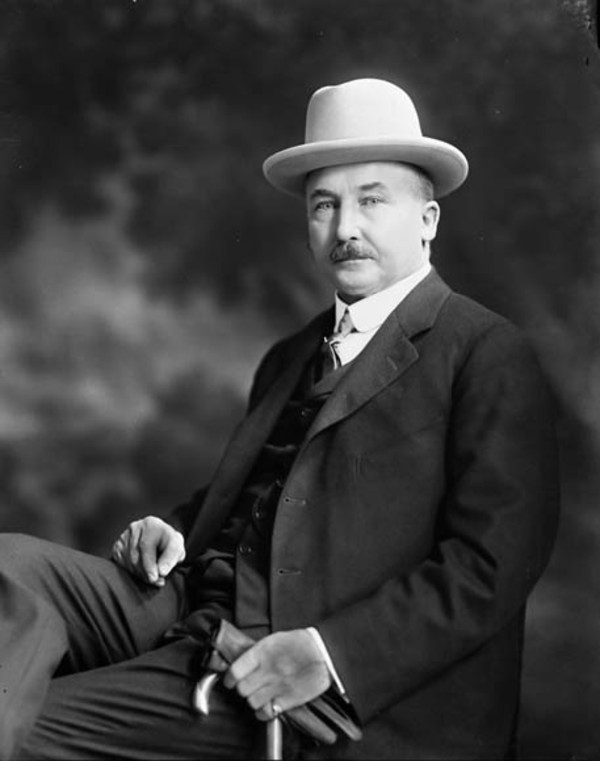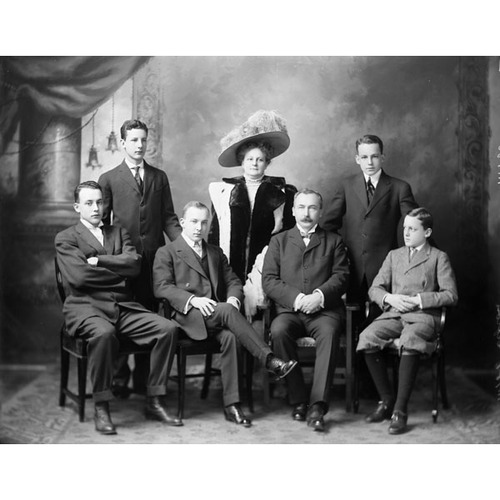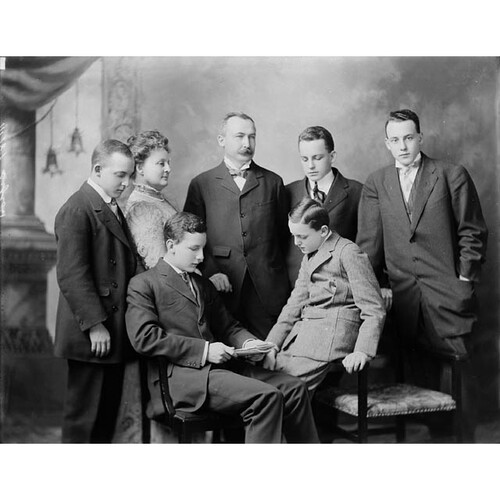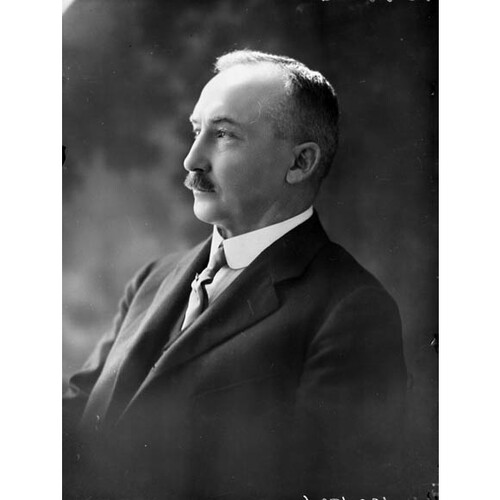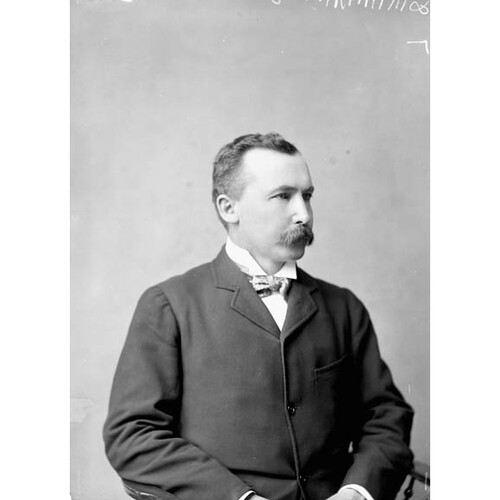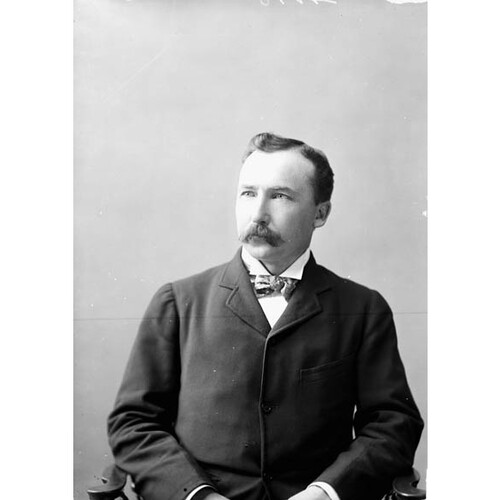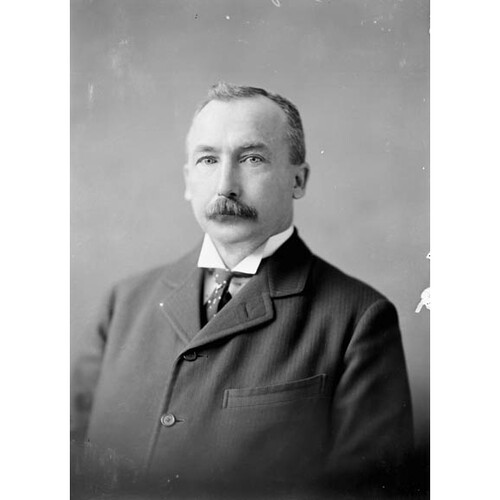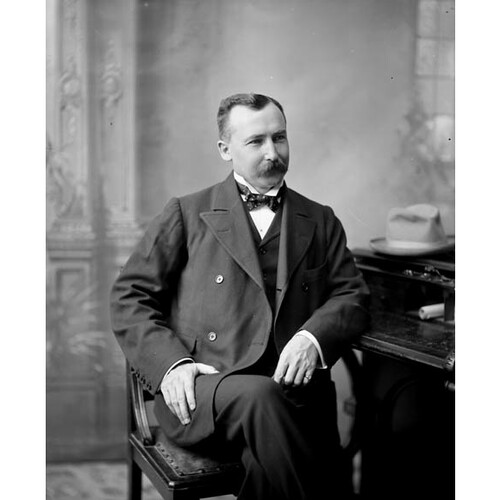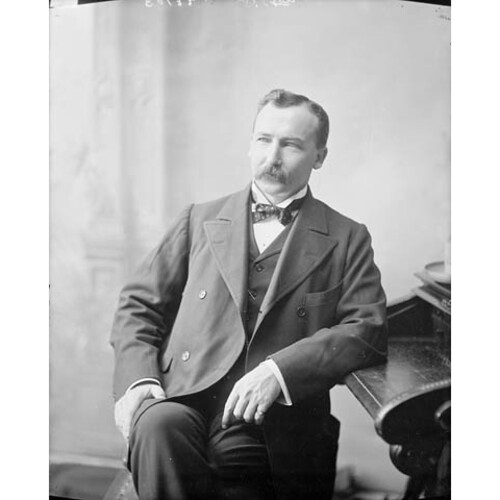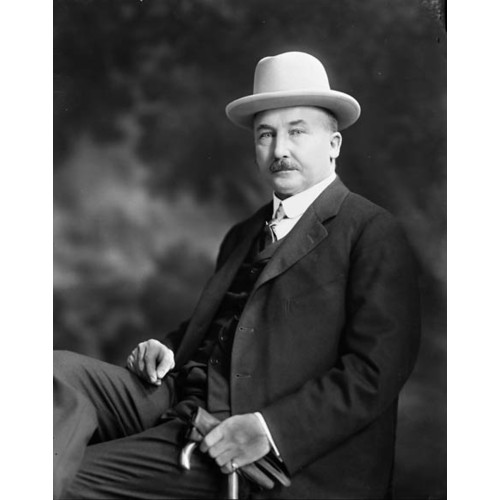SIFTON, Sir CLIFFORD, lawyer, politician, newspaper publisher, and office holder; b. 10 March 1861 in St Johns (Arva), Upper Canada, second son of John Wright Sifton and Kate Watkins; m. 13 Aug. 1884 Elizabeth Armanella (Arma) Burrows (d. 1925), sister of Theodore Arthur Burrows, in Winnipeg, and they had five sons, one of whom predeceased him; d. 17 April 1929 in New York City and was buried in Toronto.
Clifford Sifton represented the second Canadian-born generation of descendants of Anglo-Irish gentry who had settled in Upper Canada in 1818 and 1819. His father, John Wright Sifton, was a farmer and a small oil producer in Lambton County. After Clifford’s birth he became a railway contractor in Brant County and later a businessman in London. Throughout his life he was an active and devout Wesleyan Methodist and a prohibitionist. A long-time supporter of the moralistic, crusading politics of George Brown* and Alexander Mackenzie*, John Sifton was rewarded in 1874 by Mackenzie’s Liberal government with contracts to build a telegraph line northwest of Winnipeg and two sections of the Canada Pacific Railway, east of Selkirk and west of Port Arthur (Thunder Bay), Ont. The following year he moved his family to Manitoba, where he also farmed and continued to be involved in politics.
Clifford thus was educated in various public schools, at a private boys’ school in Dundas, Ont., and at high schools in London and Winnipeg. He graduated at age 15. A boyhood attack of scarlet fever had left him partially deaf, a handicap that would worsen throughout his life. In an effort to overcome the impediment he developed a rigorous self-discipline that would lead to rapid academic advancement and numerous awards. He attended Victoria College in Cobourg, Ont., from 1876 to 1880, graduating the gold medallist of his class. Following two years of articling with the Winnipeg law firm of Samuel Clarke Biggs, he was called to the Manitoba bar in 1882.
Sifton’s family had recently moved to the newly created boom town of Brandon and there he established a law practice in which his elder brother, Arthur Lewis Watkins Sifton, shortly became a partner. Like most lawyers on the Canadian settlement frontier, he developed an expertise in land and homestead law, and he speculated in real estate. He appears, however, to have had little intention of pursuing a career in law; his real avocation from early adulthood was politics.
Such a choice probably came naturally to young Sifton. His father had held minor positions in local politics in Upper Canada and had worked in Mackenzie’s campaigns. Since 1878 he had tried, more often with failure than with success, to launch a political career in Manitoba. Clifford’s first direct intervention in politics occurred in 1882 when he spoke in support of his father’s ill-fated attempt at re-election to the Manitoba legislature. From 1883 to 1885 he was active in the Manitoba and North West Farmers’ Union and its successor, the Manitoba and North-West Farmers’ Co-operative and Protective Union. Both were agrarian protest organizations that Liberal politicians used to help establish the Manitoba Liberal party as the voice of western protest against the federal Conservative government of Sir John A. Macdonald* and against what the Liberals believed was Macdonald’s “puppet,” the provincial government of John Norquay*. The Manitoba Liberals founded a permanent organization in 1885 and nearly defeated the Norquay government in the election of the following year, mainly on the subject of Ottawa’s disallowance of provincial railway charters and more broadly on issues of provincial rights. Clifford performed strongly in supporting his father’s last, and failed, campaign in 1886.
The momentum lay with the provincial Liberals under Thomas Greenway*. They won a convincing victory in the election of 1888, in which Clifford stood successfully for North Brandon. The election marked the triumph of Manitoba in its long struggle with the federal government, which sought to maintain the Canadian Pacific Railway’s monopoly against the province’s determination to provide effective competition and reduce freight rates. It also marked what historian William Lewis Morton* called “the triumph of Ontario democracy,” the election of a government dominated by newcomers – most from Ontario – and the final rejection of a government that at least had paid lip-service to respecting the population and traditions that pre-dated provincehood in 1870.
No issue so clearly symbolized this change as the Manitoba school question. In 1890 Greenway’s government tabled legislation to create a department of education and a system of so-called “national schools” that would be the only system supported by provincial tax dollars. Denominational schools were permitted, but were not to be tax-supported, a condition that would ultimately doom them. Immensely popular, the legislation nonetheless constituted a serious threat to the agreement embedded in the Manitoba Act of 1870 which had sought to enshrine guarantees that the Catholic population would control its own publicly supported school system. French-speaking Catholics viewed their schools as crucial to their cultural survival and worked closely with English-speaking Catholics to oppose the new system. Aided by the federal government, the Catholic minority immediately launched Barrett v. City of Winnipeg [see John Kelly Barrett*] to challenge the legislation.
Sifton, who had spoken ably in support of the legislation in 1890, was named attorney general of Manitoba on 14 May 1891 and provincial lands commissioner the following day. In May 1892 he also became minister of education. Meanwhile, Barrett v. City of Winnipeg had wound its way through the courts. In November 1890 and February 1891 the Manitoba courts had upheld the Public Schools Act of 1890, but in October the Supreme Court of Canada under Chief Justice Sir William Johnston Ritchie* ruled that it violated the minority’s rights under the Manitoba Act. Using a brilliant strategy, Sifton arranged to have the Anglicans challenge the Manitoba legislation in light of the Supreme Court’s decision. He then appealed both the Catholics’ case and the Anglicans’ (Logan v. City of Winnipeg) to the Judicial Committee of the Privy Council in England. The intent was to emphasize the possibility of fragmentation of the school system should the minority’s contention be upheld. On 30 July 1892 the JCPC found in favour of the province.
Early in 1893 the Catholic minority launched another legal challenge. Brophy and others v. Attorney-General of Manitoba asked the courts to determine whether the legislation of 1890 adversely affected Catholic rights acquired since 1870 and also whether the federal government had the power to remedy the grievance. When the JCPC ruled early in 1895 that the minority did in fact have an appealable grievance and that the federal government had the power to remedy it, the issue was thrown back into the political arena. Sifton was determined that the public should view any action by Ottawa, not as a moral imperative or a legal requirement, but as a purely political decision calculated to win support in Quebec. The federal government, he told the Manitoba legislature, had no right to interfere with the expressed will of the people of Manitoba. During 1895 he brilliantly outmanoeuvred the federal government of Sir Mackenzie Bowell*, refused requests to compromise, and engineered a provincial election early in 1896. The result was an overwhelming endorsement of the Greenway government. The issue also contributed to the victory of the Liberals under Wilfrid Laurier* in the federal election of June 1896. The two leaders then hammered out the so-called Laurier–Greenway compromise, with Sifton as the dominant figure on the Manitoba side of the negotiations. The settlement provided for limited religious instruction and for bilingual education where ten or more pupils had a native language other than English. Nevertheless, the minority failed entirely to regain either segregation of Catholic pupils or control of their education, which to it were the crucial issues.
Sifton had quickly become a dominant presence in the Greenway government. He successfully pressed the premier to make important changes in the cabinet, devised railway policy, and was the dynamic force that kept the Liberal party organization in fighting trim. During his years in Manitoba politics, recession and depression hampered economic growth. Despite the end of the CPR monopoly in 1888, which allowed for the completion of the Red River Valley Railway and resulted in a slight lowering of freight rates, expansion of the railway system ground to a halt. In 1895 Sifton devised a system of financing railways through provincial government guarantees of the principal and interest on railway bonds. Working with railway contractors Donald Mann* and William Mackenzie, he arranged for a line into the Dauphin district, the Lake Manitoba Railway, which would be the beginning of the Canadian Northern Railway system. His apparently painless method of financing railways became irresistibly attractive to governments in the boom years of the early 20th century.
Sifton had also gained a reputation in Manitoba as the organizing genius behind the electoral successes of the Greenway government. Every campaign was planned thoroughly and energetically, government propaganda blanketed the constituencies with carefully targeted partisan messages, and everywhere the government aggressively confronted its Conservative “enemy.” Sifton’s opponents claimed that he did not shy away from questionable tactics – buying votes, supplying liquor, manipulating voters’ lists, and the like – but they were never able to substantiate these claims in court.
As his reward for his part in the settlement of the Manitoba school question, Sifton was sworn into Laurier’s cabinet as minister of the interior and superintendent general of Indian affairs on 17 Nov. 1896, a few days before the school compromise was officially announced. His new portfolio entailed responsibility for immigration and for the settlement of the prairie west. After moving to Ottawa, Sifton appeared to abandon his western Liberal radicalism and to embrace the principles of John A. Macdonald’s policies of national development: protective tariffs, expansion of railways, and settlement of an agricultural population in the west. These policies would give Canada a measure of economic independence and diversify its economy, open new areas to settlement, provide access to untapped resources, and integrate the west into the dominion both as a consumer of domestic manufactures and as a producer of foodstuffs and other natural products in the international market. Sifton also believed that centralizing the administration of these policies would be more efficient than expanding regional or local autonomy. His focus on material development and a strong central government and his belief in the fundamentally British Protestant character of Canada outside Quebec did not incline him to view generously the aspirations of minorities, particularly that of French Canada. In the end he and Laurier viewed the country from quite different perspectives that would prove difficult to reconcile.
The Laurier government took office in propitious times. The domestic economy was recovering, the international economy was expanding, there was new demand in Europe for North American foodstuffs and manufactures, the last waves of emigrants from central and eastern Europe were ready to go abroad, and capitalists from Britain and the United States were prepared to invest unprecedented amounts of money in Canada. Effective methods of agriculture were being developed in the west, and a transportation and service infrastructure was rapidly growing; along with rising prices and lower shipping costs, these factors made farming in the west much more attractive and less risky.
In this context Sifton transformed the immigration branch of the Department of the Interior. Formerly salaried immigration agents suddenly found themselves working for commission, based on the actual number of immigrants settling in the west. The department aggressively sold western Canada: millions of advertisements in various languages were broadcast in Europe; Canada was touted at agricultural fairs; schools in Britain received great quantities of free information about Canada; journalists were given free tours of the west so that they could write about it. Whereas Canadian promotion of immigration from the United States had been largely targeted at repatriation – trying to lure former Canadians back to Canada – Sifton placed the emphasis on attracting agricultural Americans to come to Canada. Tens of thousands responded, searching for large, cheap tracts of land unavailable in the United States or for a block of land for a particular ethnic or religious minority. The government favoured immigrants from the United States because they brought capital, goods, and experience in western farming; moreover, most Canadians viewed them as ethnically compatible. Efforts in Britain were politically necessary, given Canada’s heritage, but generally less successful. Only a minority of British immigrants appeared to be interested in the rigours of western farming [see Isaac Montgomery Barr*]; others were interested in domestic service or in mainly urban labour. Sifton also worked to encourage settlers from central and eastern Europe. They came in unprecedented numbers [see Jósef Olesków*; Peter Vasil’evich Verigin] and were generally very successful farmers, although they also created hostility amongst some English-speaking Canadians [see Patrick Gammie Laurie*], who saw them as a threat to the ethnic traditions and social values of the majority culture.
Sifton’s primary concern was to settle the west with a productive agricultural population: hence his encouragement of American, British, German, Scandinavian, and eastern European farmers. Those whom he believed unlikely to succeed as prairie farmers and therefore more likely to settle in Canadian cities where he feared they would compete with Canadian workers and cause social problems – British city dwellers, southern Europeans, blacks, and Orientals – were not encouraged and were even actively discouraged from coming to Canada. Overall, the annual number of immigrants to Canada rose from 16,835 in 1896 to 55,747 in 1901 and to 141,465 in 1905, though probably less than half of them were intending to settle in the west. Just as he was interested in attracting agricultural immigrants, Sifton wanted to get them safely located on farms. He greatly increased the survey of western lands, from 1,600,000 acres in 1901 to 12,700,000 acres in 1904. Railway companies were pressured to select the land owing them under land-grant schemes and free up the remaining lands for homesteading. Immigrants were carefully cultivated from the time of their arrival in Canadian ports until they located on a homestead.
Other areas that came under Sifton’s jurisdiction were treated in the context of efficiency in achieving the government’s overall goals. The Geological Survey of Canada [see George Mercer Dawson*; Robert Bell*] was partially reoriented from a largely scientific entity to a body expected to locate mineral deposits and aggressively encourage their exploitation. National parks were developed to attract tourists, but also for other purposes, such as mining. Sifton was instrumental in the negotiation with the CPR’s president, William Cornelius Van Horne*, of the contract for the construction of a branch line popularly known as the Crow’s Nest Pass Railway [see John Duncan McArthur], which linked mining and forest resources into Canada’s east-west rail network. The historic Crowsnest Pass agreement passed by parliament in 1897 significantly lowered freight rates on manufactured goods brought into the west, and on grain transported from it to the Lakehead. In addition, Sifton was the strongest advocate in the cabinet of Mackenzie’s and Mann’s Canadian Northern Railway, enabling it in 1903 to secure its dream of building to transcontinental status, along with the National Transcontinental line favoured by Laurier and a majority of other Liberals. Sifton also was influential in holding the Liberal government to a course of moderate protectionism that steered between the high tariff views of the manufacturers, many Tories, and some prominent Liberals and the low tariff, free trade convictions of many Liberals, especially in the west.
Lost in the rush for settlement and economic growth were the native peoples. Sharing the common assumptions of his day about them, Sifton aimed at cutting costs in the administration of the Department of Indian Affairs [see Amédée-Emmanuel Forget] and in native education. He did not believe that native peoples could contribute in a significant way to the material expansion of the nation. In certain cases he permitted his officials to encourage the natives to give up some of their reserve lands for speculation and settlement. He also was responsible in 1899 for approving arrangements for Treaty No.8 [see David Laird*; James Andrew Joseph McKenna*; Mostos*], which resulted in the surrender of a large portion of present-day northern Alberta, Saskatchewan, and British Columbia, as well as part of the southern Northwest Territories. This was achieved mainly to allow the safe passage of prospectors heading for the Yukon goldfields.
Sifton was the minister who had greatest responsibility for the administration of the Yukon territory during the gold rush which originated in 1897. The problems he faced essentially were in three areas: the establishment of civil government; the regulation of the extraction of gold and related taxes or royalties; and the negotiations with the United States over disputed territory and control of trade in the Alaskan panhandle.
The last of these issues affected and complicated the other two. Because the Americans controlled the most readily accessible routes to the Yukon, they were in a position to control trade by making it difficult for Canadian-purchased goods to compete with those purchased in Seattle, Wash., or San Francisco in passing through the panhandle to Canadian territory. Sifton travelled to the disputed region in the fall of 1897 and even went to Washington, D.C., in December to try to sort out the matter. He obtained verbal assurances of American cooperation, but American delays and equivocation precluded a solution and undermined his hopes for an “all-Canadian” route to the Yukon via the Stikine River. Nationalist fervour in both Canada and the United States made it impossible for an Anglo-American joint high commission in 1898–99 to resolve outstanding difficulties between the two countries and, in any event, Sifton was one of the hardliners in the Canadian cabinet, pressing Laurier not to cave in to unsatisfactory American offers. In 1903 Laurier appointed Sifton the British agent in charge of preparing the case for the Alaska Boundary Tribunal. The judicial tribunal consisted of three Americans, one Briton, and two Canadians, Louis-Amable Jetté* and John Douglas Armour (replaced by Allen Bristol Aylesworth* after Armour’s death in July 1903). Despite Sifton’s vigorous advocacy and enthusiasm, the British who admittedly had the weaker case – lost on all the crucial decisions. Sifton concluded from the experience that the Americans would not hesitate to use their weight to secure their ends and that the British could not be relied on to defend Canadian interests.
If Canada’s freedom to establish civil government and regulate the Yukon trade was constrained by the boundary problem and the strong interest of the United States in the fate of its nationals in the goldfields, it also was limited by ignorance, poor communications, and the demands of patronage. Of the Yukon commissioners (the heads of the territorial government) selected by Sifton in the period before 1905 – Major James Morrow Walsh*, William Ogilvie, James Hamilton Ross*, and Frederick Tennyson Congdon* – only Ross was a success and his term (1901–2) was cut short by a stroke. Officials appointed by Sifton and his colleagues often were unqualified for their difficult tasks except by political connection and many of them occupied themselves with lining their pockets rather than serving the public. Despite the strenuous and repeated efforts of the opposition to link Sifton to alleged corruption in the Yukon, it was unable to prove its charges.
Sifton frequently changed mining regulations, usually because of pressure from the Yukon when officials in Ottawa failed to understand local conditions. The interests of the individualist-adventurer placer miners conflicted with those of capitalists, such as Joseph Whiteside Boyle and Arthur Newton Christie Treadgold*, who sought large concessions from the government that would justify bringing in heavy equipment to work low-grade ores. Sifton believed that the capitalists would provide greater stability to the Yukon in the long run, but opposition to the concessions, and especially to the huge development proposed in the Treadgold concession, resulted in the failure of that policy before 1905, although in the end Sifton was proven correct.
The Yukon experience was not typical of Sifton’s political management. Indeed, he had rapidly acquired a reputation as one of the ablest of Laurier’s English-speaking colleagues in the area of manipulation of patronage and management of elections. Instrumental to his success was his purchase of the Manitoba Free Press in 1897–98. First under the editorship of Arnott James Magurn and then, from 1901, under the brilliant John Wesley Dafoe*, the paper became a commanding presence in the metropolitan growth of Winnipeg and the expansion of its hinterland from the Lakehead to the Rockies. On one level the paper was a business investment for Sifton and he sought out leading newspapermen such as Dafoe and Edward Hamilton Macklin, the business manager of the Free Press from 1900, who shared his vision of the growing potential of western Canada and the opportunities it created for the paper. On another level the paper was a political investment, a weighty voice in support of the Laurier administration, a source of admittedly slanted editorials and news columns for the Liberal newspaper network that Sifton was at pains to establish across the west, and a vital organ at election time. Through the Free Press he defended the record of his department and of the Laurier government generally. At the same time, Magurn, and then Dafoe, served as important conduits of information about western conditions. By 1904 there were 35 papers in Manitoba, 22 in the North-West Territories, and 16 in British Columbia on the Liberal patronage list. Although Sifton had a direct financial interest in two or three of them, most were kept in line by the Liberal inclinations of their proprietors and by patronage – usually government advertisements or contracts.
Playing a key role in the Liberal election victories of 1900 and 1904, successful in promoting the development of the west, and plainly carrying great weight in Laurier’s cabinet, Sifton astounded the country with his abrupt resignation at the end of February 1905. As he read the education clauses in the bills intended to establish the provinces of Alberta and Saskatchewan, he was convinced that they extended to the Roman Catholic minority privileges beyond those which they then possessed under the territorial government of Premier Frederick William Gordon Haultain*. He believed that the ideal for the new provinces was a single school system which would eliminate denominational differences; since that was politically impossible, he favoured preserving there the situation already existing in the territories, as defined by the territorial ordinances of 1901, which minimized denominational control. Laurier disagreed and refused to compromise on the wording. Eventually, however, Sifton’s resignation and the threat of a more widespread rebellion in his cabinet forced him to entrench the status quo. Other factors may have influenced Sifton’s decision to resign. He had exhausted himself in the previous election as well as in administration and he had been passed over by Laurier for promotion. There were also allegations that he feared to face charges of corruption or of adultery, although these charges were never substantiated. The fact that his opinion had not been sought, or his advice accepted, on an issue that normally fell under his jurisdiction and on which he was well experienced, is in itself likely sufficient cause for his resignation.
Sifton remained in parliament as a private member until 1911. Laurier made one attempt to lure him back into the cabinet, in 1907. Sifton declined, partly because the prime minister refused to make even minor reforms to his cabinet and partly because he would have been expected to assume responsibility for the exhausting and thankless task of political organization in English-speaking Canada. Outside the cabinet, Sifton seems to have had little or no influence over policy. He appeared rarely in parliament and spoke less. On 31 May 1906 he brilliantly defended his administration as minister of the interior against charges of corruption and on 20 March 1908 he gave a speech urging civil service reform that attracted much attention. At Laurier’s request he spearheaded in 1907–8 Canada’s interest in participating in the All-Red Line scheme, a plan to provide rapid passenger communication by ships and trains between Britain and her Pacific empire – especially New Zealand and Australia – via Canada (all land parts of the route were coloured red on contemporary maps). Undoubtedly Canada would have benefited significantly from the business generated, which is what attracted Sifton. Australian coolness to the project, however, combined with the prospect that the Panama Canal, then under construction, would soon be completed, undermined the rationale for the scheme and resulted in its being quietly dropped.
The role of backbencher was not congenial to Sifton. He also was growing out of sympathy with the government and seriously considered not running in the general election of 1908. At the last minute he appears to have been persuaded that not to run would be viewed as capitulating to charges of corruption and he worked strongly to salvage the government’s organization in Ontario as well as to ensure his own re-election for Brandon. His alienation from the government climaxed in January 1911 when Laurier’s minister of finance, William Stevens Fielding, announced a reciprocity agreement with the United States. The two countries agreed to eliminate tariffs on a wide range of agricultural and fish products, on wood pulp and pulpwood, on a limited number of partly manufactured products, and on barbed wire. They also agreed to a common level of tariff on a further list of products and to reduced tariffs on an additional list. It was not full free trade and it largely left Canadian manufactures protected, but it seemed to go a long way toward free trade and linking the economies of the two countries. Sifton opposed the agreement with a powerful speech in parliament at the end of February. The proposal, he asserted, ran counter to historic efforts to create an east-west trading network and to maintain trade linkages with Britain and the empire, to give Canada not only economic unity, but a measure of independence from the great attraction and dominance of the United States. He decided not to run again for parliament, but did work to link disaffected Liberal businessmen with the Conservative anti-reciprocity campaign and to organize Ontario for the Conservatives. The smashing Tory triumph in the general election in September owed not a little to Sifton’s efforts, as Conservative leader Robert Laird Borden* admitted. The extent to which Sifton had abandoned his western free-trade principles was now obvious. His former supporters in Brandon and many of his former Liberal colleagues felt betrayed.
In May 1909 Laurier had appointed Sifton to chair the newly created Canadian Commission of Conservation and Borden permitted him to continue until his resignation in November 1918. James White was appointed secretary in 1909, he would become deputy chairman in 1913. The commission was a response to American conservation initiatives under President Theodore Roosevelt and a recognition that conservation required action on the part of Canada and Mexico as well as the United States. Conservation was understood to involve efficient management for ongoing exploitation of resources; in no sense was it preservation. The conservation movement of this period reflected American Progressive ideals of individual and collective action in order to bring about greater economic, social, and political efficiency and to prevent squandering of resources. Sifton embraced these ideals and hoped that as chairman he would be able to make a significant impact. The commission’s mandate was to investigate and publicize issues relating to conservation of natural resources and public health; it had neither executive nor administrative powers. Because it trespassed on areas of provincial jurisdiction, it had to be particularly sensitive to provincial concerns. Intended to act at arm’s length from government departments, under Sifton it indeed acted quite independently. He established seven committees (forests; lands; minerals; water and water-power; fisheries, game, and fur-bearing animals; public health; press and cooperating organizations), each chaired by a member of the commission and each free to appoint experts and conduct its business as it saw fit. The commission as a whole held meetings once each year, from which its annual reports were generated. Sifton spoke frequently and was an aggressive supporter of its wide range of activities. Only his strength and prestige preserved the commission from ministerial resentment of its independence and discontent among civil servants over what they regarded as its intrusions into their areas of jurisdiction. It was phased out by the government by 1921, a fate that obscured its achievements: many dozens of scientific publications and catalogues of resources, a significant impact on federal and provincial statutes regulating the exploitation of resources, the encouragement of farmers and fishermen, and the growth of public health standards and city planning.
For personal reasons, Sifton, who would be knighted on 1 Jan. 1915, was thoroughly devoted to the war effort from 1914. Four of his sons were in the military and two, Clifford and Wilfred Victor, were wounded and earned the Distinguished Service Order. Sifton helped to arrange the formation and financing of the No.1 Automobile Machine-Gun Brigade (later the 1st Canadian Motor Machine Gun Brigade) and he and his wife spent much of the war in Britain to be closer to their sons. Indeed, he had been out of the country almost a year when he returned in the spring of 1917 to be plunged into the crisis over conscription and the formation of a coalition government. Unhappy with the Borden government’s record, not trusting Laurier to pursue an all-out win-the-war policy, and missing the nuances of recent developments in Ottawa, Sifton appeared inconsistent, seeming to side at first with Laurier, who opposed conscription for overseas service, and then with Borden, who was convinced that conscription was essential. He ultimately was instrumental in pulling together pro-conscription western Liberals, including his brother Arthur, Thomas Alexander Crerar*, and James Alexander Calder*, to join with Borden in the Union government. He was equally critical in engineering the Union government’s victory in the election of December 1917. It proved to be his last serious involvement in politics. Although his major objective had been to secure a conscriptionist, win-the-war government, he also hoped that the shattering of traditional political loyalties in 1917, added to the upheaval of war, would lead to a new era of reform. The body politic would then be cleansed, he anticipated, and there would result universal suffrage, a reformed civil service, and an end to liquor traffic, slums, and poverty. In this respect, the Union government proved to be a great disappointment to him.
Sifton and his family moved to Toronto in 1919 and during the last decade of his life his public involvement was increasingly marginal. He was deeply mistrusted by Prime Minister William Lyon Mackenzie King* and many Liberals, by the Progressive party (for whom he represented a corrupt past, not a reformed future), and of course by the Conservatives (to whom he was a long-term enemy and a person of unpredictable loyalties). He had some hope that the Progressives, at least as personified by Crerar, would be a reforming influence in Canadian politics, but was disappointed at how they dissipated their early promise. King overcame his dislike of Sifton sufficiently to consult with him periodically and to persuade him to deliver several speeches in the Liberal interest during the election of 1925. King and Sifton shared a belief that Canada should take an isolationist position in the world, moving toward greater independence from Britain to secure her future freedom of action, and through public speeches and interviews with King and Dafoe, Sifton at least reinforced King’s policies in this area.
In 1925 Sifton, with his sons, became deeply involved in an effort to revive the fortunes of the Montreal, Ottawa and Georgian Bay Canal Company, which hoped to connect the Ottawa and Mattawa rivers via Lake Nipissing to Georgian Bay in a shorter route for shipping than the Great Lakes and also to develop the hydroelectric potential along the route. The Ontario and Quebec governments, Ontario Hydro, and private hydroelectric power and railway interests combined to pressure the federal government to kill the project in 1927, portraying the Siftons as seeking a monopoly to inflate their already vast fortune.
Sifton’s health was in decline and he died of heart failure in New York City, where he had gone to consult a specialist, in 1929. He was buried on 19 April in Mount Pleasant Cemetery in Toronto. His estate, by the highest reckoning, which was that of the Ontario government seeking estate taxes, did not exceed $10 million; the family valued it at about one-third this amount. Either way, much of it was tied up in the value of the Manitoba Free Press. Sifton was rich, but not the vastly wealthy robber baron portrayed in the popular press.
Sir Clifford Sifton was, and remains, a controversial figure. He never grasped the legitimate ambitions of French Canadians for equality of status. He was renowned for his mastery of machine politics and patronage; charges of corruption – if never proven – dogged his entire career. At the same time he contributed significantly to the success of the Laurier government, to the settlement of western Canada, and to the development of the transportation and other infrastructure necessary for an integrated national economy. He always had a populist streak in his politics and a strong nationalist inclination in dealing with Great Britain and the United States. Perhaps he was not quite a statesman, but he was a politician of great vision and influence.
[The principal manuscript source for this study is the Sifton papers at NA, MG 27, II, D15. The collection is substantially complete for Sifton’s political career from 1896 to 1905, but is sketchier for his earlier and later life and for his business investments. It contains almost nothing on his private family life or his personal interests. Also of critical importance are the following collections at the NA: Macdonald papers (MG 26, A), Laurier papers (MG 26, G), Borden papers (MG 26, H), King papers (MG 26, J), and Dafoe papers (MG 30, D45). There is a small collection of Sifton papers at the AM (MG 14, B41), which also houses the important Greenway papers (GR 1662) and Schultz papers (MG 12, E). The Univ. of Man. Libraries, Dept. of Arch. and Special Coll. (Winnipeg), holds the valuable J. W. Dafoe fonds. A selection of letters between Dafoe and Sifton during the last decade of Sifton’s life was edited by Ramsay Cook and published as The Dafoe–Sifton correspondence, 1919–1927 (Altona, Man., 1966).
There are two principal biographies of Sifton. The first is a fine, sympathetic work by his long-time friend and confidant, J. W. Dafoe, Clifford Sifton in relation to his times (Toronto, 1931). The other is the author’s study, Clifford Sifton (2v., Vancouver and London, 1981–85). The second of the two volumes contains a full bibliography, including a list of Sifton’s writings. Two more recent works that are important in understanding Sifton’s career are Réal Bélanger, Wilfrid Laurier; quand la politique devient passion (Québec et Montréal, 1986), and M. F. Girard, L’écologisme retrouvé: essor et déclin de la Commission de la conservation du Canada: 1909–1921 (Ottawa, 1994). d.j.h.]
Cite This Article
David J. Hall, “SIFTON, Sir CLIFFORD,” in Dictionary of Canadian Biography, vol. 15, University of Toronto/Université Laval, 2003–, accessed April 20, 2025, https://www.biographi.ca/en/bio/sifton_clifford_15E.html.
The citation above shows the format for footnotes and endnotes according to the Chicago manual of style (16th edition). Information to be used in other citation formats:
| Permalink: | https://www.biographi.ca/en/bio/sifton_clifford_15E.html |
| Author of Article: | David J. Hall |
| Title of Article: | SIFTON, Sir CLIFFORD |
| Publication Name: | Dictionary of Canadian Biography, vol. 15 |
| Publisher: | University of Toronto/Université Laval |
| Year of revision: | 2005 |
| Access Date: | April 20, 2025 |


